30 October 2023
![]() 10 mins Read
10 mins Read
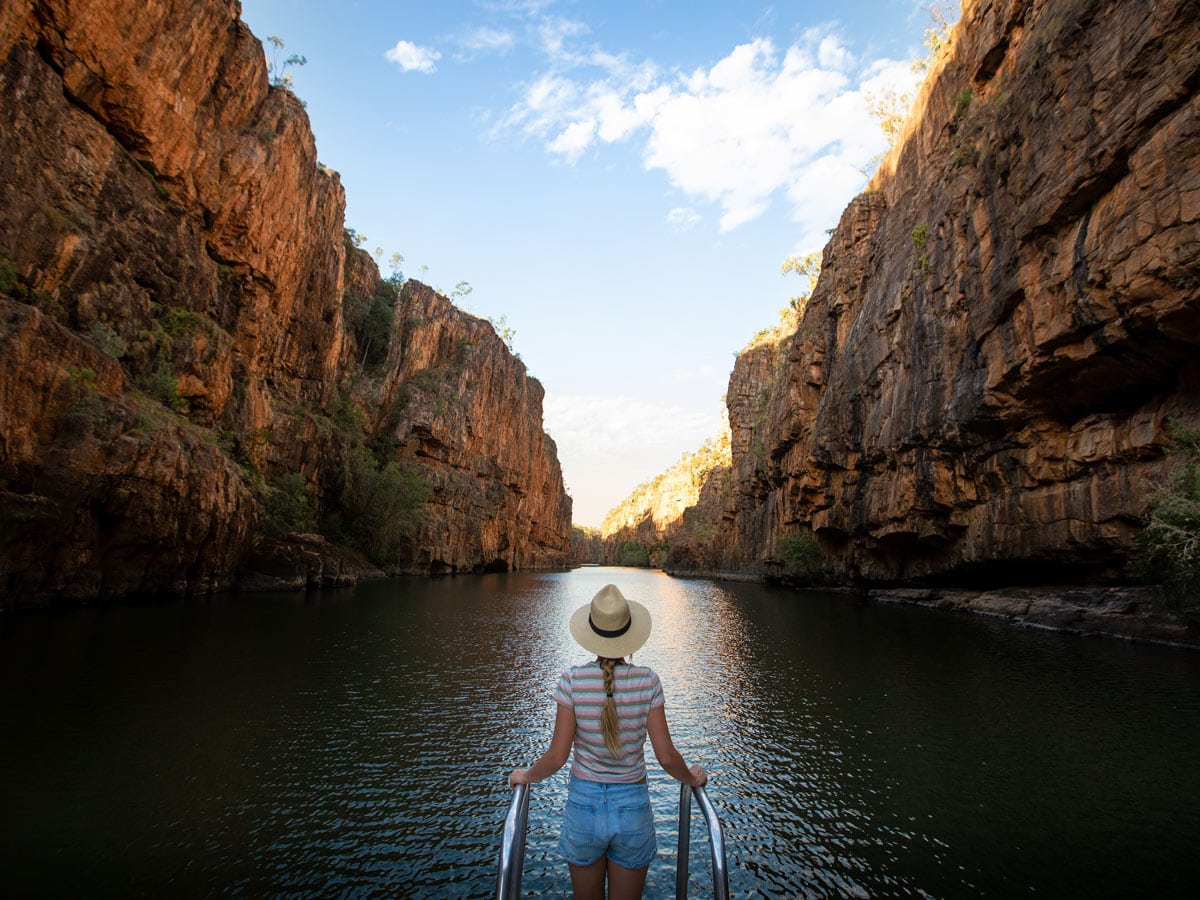
Starting in Tropical North Queensland and finishing in the Northern Territory’s vibrant capital, the Cairns to Darwin road trip is an epic 2600-kilometre journey of a lifetime passing through an incredibly diverse landscape.
Taking around 40 hours to drive with fascinating stops and detours along the way, the eastern half of the Savannah Way is a unique opportunity to uncover the unexpected and discover tiny townships, relax in hot springs, look around in awe at ancient gorges, and wander through stunning national parks. If you’re up for a bigger challenge and want to take on the entire Savannah Way between Cairns and Western Australia, see our guide to the western half — Darwin to Broome.
Ready to jump right in? Here’s our 14-day road trip itinerary outlining the why, what, and where of how to explore from Cairns to Darwin.
Distance: 260kms — around 3.5 hours
Leave early and follow the Bruce Highway south from Cairns. Turn onto Route 52 into the rainforest-clad Atherton Tablelands. Take a break at Lake Eacham and admire Little Millstream Falls near Ravenshoe.
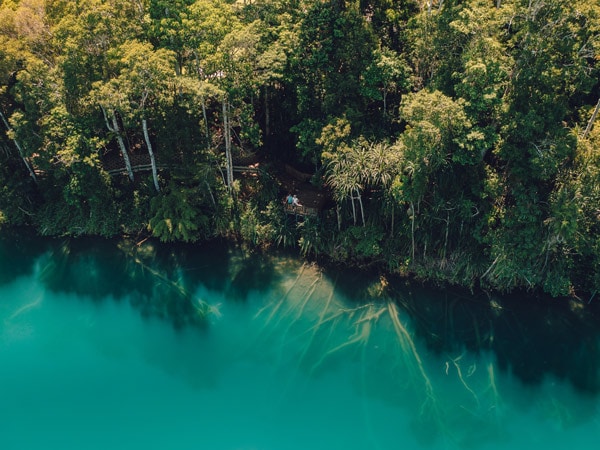
Take in the beauty at Lake Eacham. (Image: Tourism and Events Queensland)
You’re now on Route 1 (National Highway) all the way to Darwin. Continue west to the Undara Experience – try to arrive in time for a sunset wildlife tour. Accommodation here ranges from cabins to converted railway carriages and a campground.
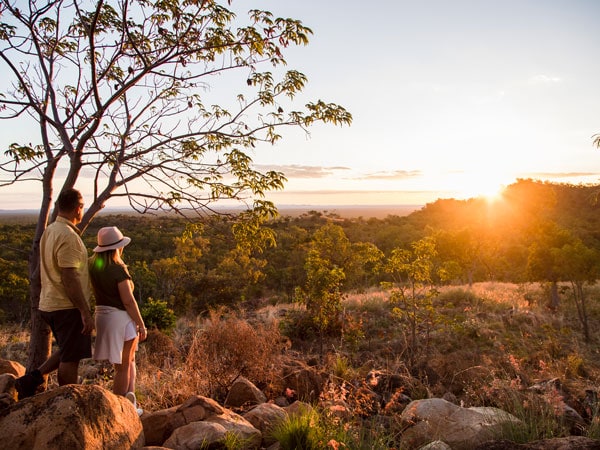
Immerse yourself in the wilderness at sunset with Undara Experience. (Image: Tourism and Events Queensland)
After yesterday’s long drive, start with a Bush Breakfast and relax in Undara Volcanic National Park where the outback begins and 164 ancient volcanoes pepper the landscape.
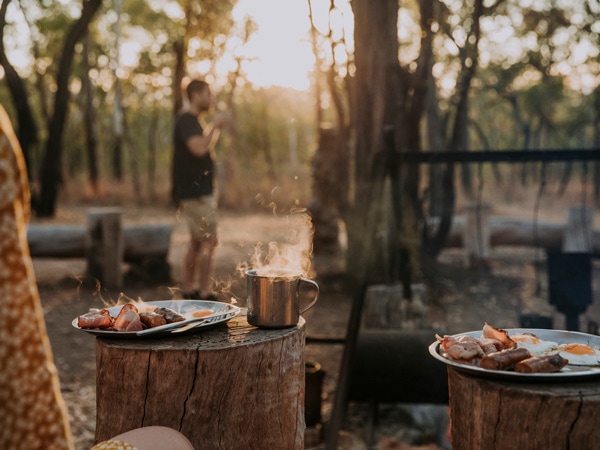
Refuel in the morning before exploring Undara. (Image: Tourism and Events Queensland)
Early morning is perfect for admiring the abundant birdlife before exploring the remarkable lava tubes. Finish with authentic country cooking and outback hospitality at the on-site Fettler’s Iron Pot Bistro.
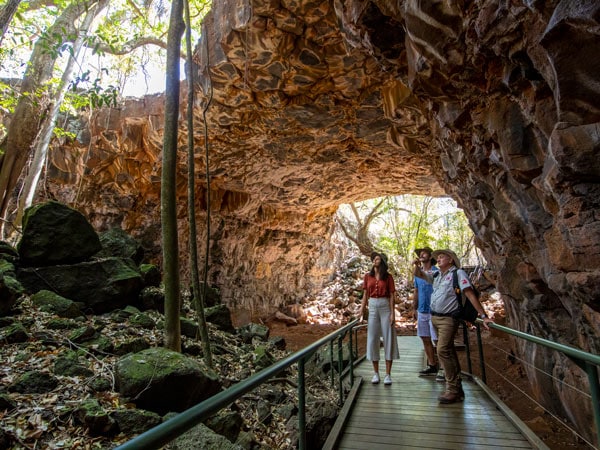
Explore the remarkable lava tubes. (Image: Tourism and Events Queensland)
Distance: 250kms — around 3.5 hours
Continue west and you’ll come across Talaroo Hot Springs, one of Outback Queensland’s most extraordinary geological wonders.
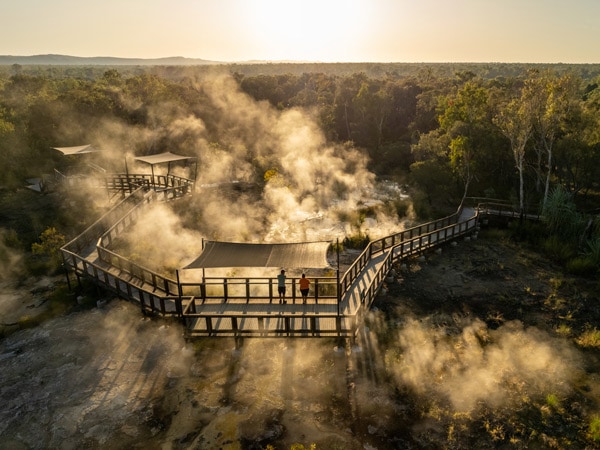
Don’t miss seeing Talaroo Hot Springs; a geological wonder hidden in the outback. (Image: Tourism and Events Queensland)
Its surreal landscape of pools combined with the Aboriginal hospitality of the Ewamian people is a wonderful experience. Join a guided tour to uncover the spring’s history and dip your feet in the healing water.
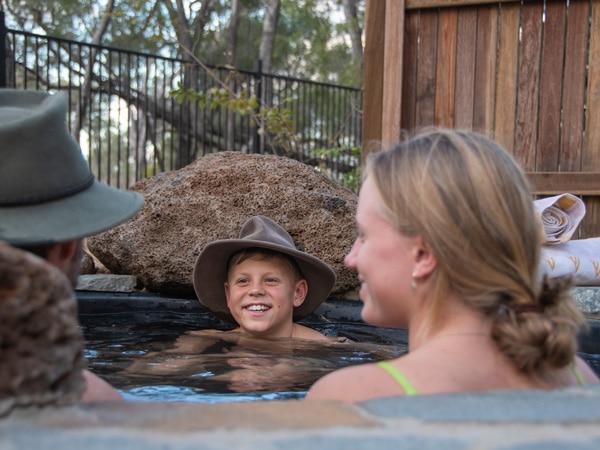
Take a warm dip in the healing waters. of the spring. (Image: Tourism and Events Queensland)
Make your way to Cobbold Gorge and stay the night at Gilberton Outback Retreat, where you can enjoy a little luxury at its infinity pool with a swim-up bar.
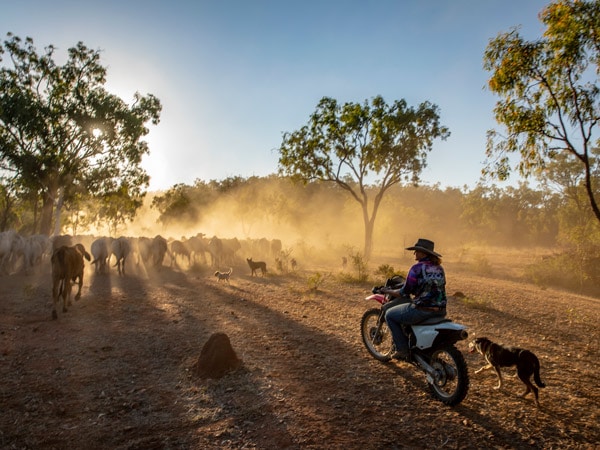
Get off-grid at Gilberton Outback Retreat. (Image: Tourism and Events Queensland)
In the heart of the Gulf Savannah region, Cobbold Gorge is a true Outback Queensland destination well worth the stop. On a guided day tour, enjoy a cruise surrounded by sculpted red sandstone cliffs, walk atop its walls, and across Australia’s first fully glass bridge, exploring the geological landforms along the way. With the rest of the day to spare, go bushwalking, bird watching, kayaking, mountain biking, or even treat yourself to a helicopter flight.
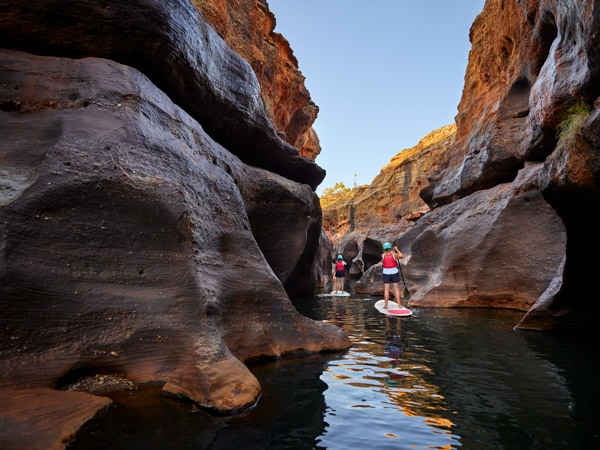
Go stand-up paddleboarding at Cobbold Gorge. (Image: Tourism and Events Queensland)
Note: Cobbold Gorge is open seasonally from 1 April to 31 October – perfect for travelling in the dry season.
Distance: 230kms — around 3 hours
Back on the road again, you’ll pass through sleepy Georgetown on the Etheridge River, a former gold mining settlement. Stop in for a bite to eat and a quick visit to The TerrEstrial Centre to see the Ted Elliott Mineral Collection, a world-class exhibition of over 4500 minerals, gems, crystals, and fossils.
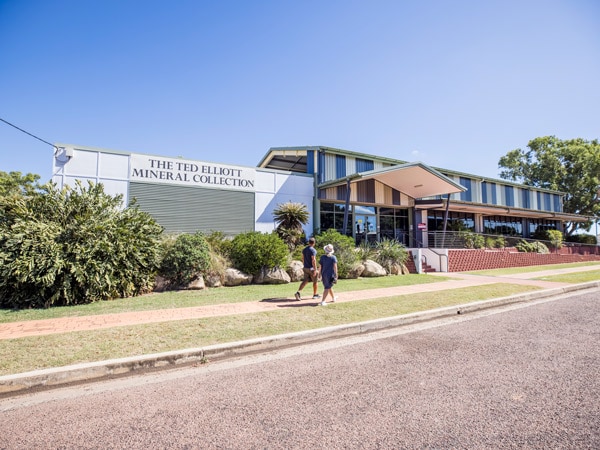
Visit TerrEstrial Visitor Information Centre to see the Ted Elliott Mineral Collection. (Image: Tourism and Events Queensland)
Your destination for the night is the beautifully quaint town of Croydon, which also has a gold-mining history and an interesting heritage precinct. Grab a self-guide brochure from the True Blue Visitor Centre to explore the town’s police station, jail, Sergeant’s residence, town hall, and courthouse.
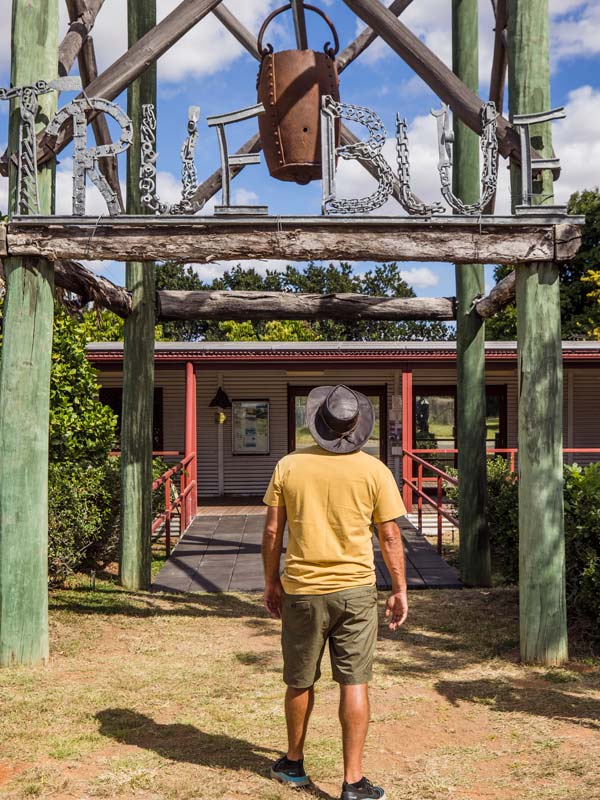
Jumpstart your day by picking up info on Croydon at the True Blue Visitor Centre. (Image: Tourism and Events Queensland)
If you prefer the great outdoors, Lake Belmore is close by for barramundi fishing and year-round recreational activities.
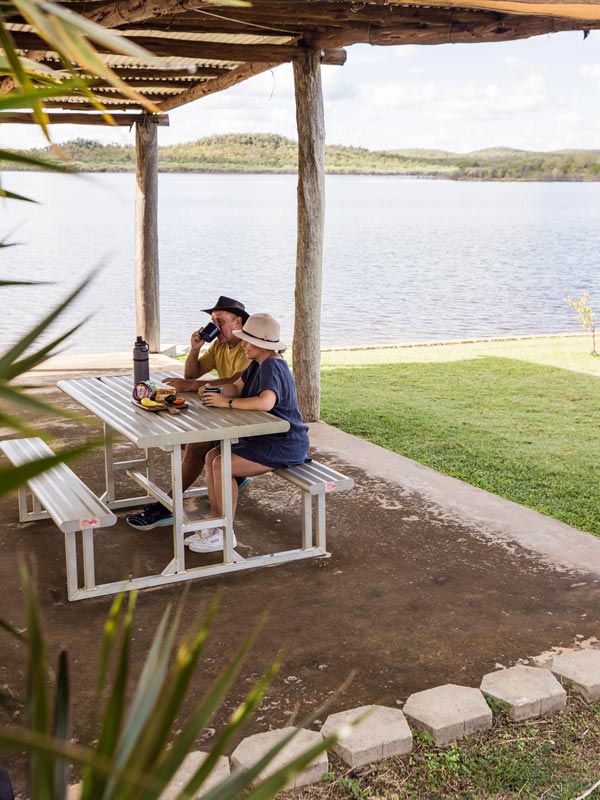
Have a picnic at Lake Belmore. (Image: Tourism and Events Queensland)
Distance: 225kms — around 2.5 hours
The Savannah Way skirts the Gulf of Carpentaria, but this is one of a few chances to see the coast. First, pass through Mutton Hole Wetlands north of Normanton for stunning birdlife, including brolgas and black swans.
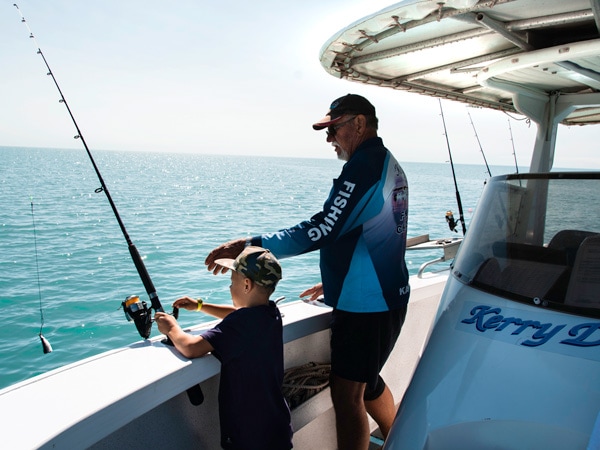
Get out on the water at Karumba. (Image: Tourism and Events Queensland)
Karumba is a great spot to charter a fishing boat. Visit the fascinating Barramundi Discovery Centre and enjoy an evening meal at Sunset Tavern where the sun meets the sea.
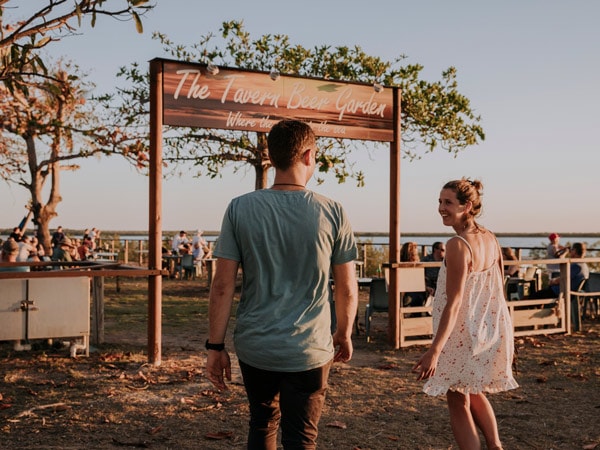
The Sunset Tavern is a beautiful spot to end the day. (Image: Tourism and Events Queensland)
Distance: 370kms — around 4.5 hours
It’s hard to resist pausing in Normanton for a photo at its eight-metre crocodile (relax, it’s a replica) and bright Purple Pub.
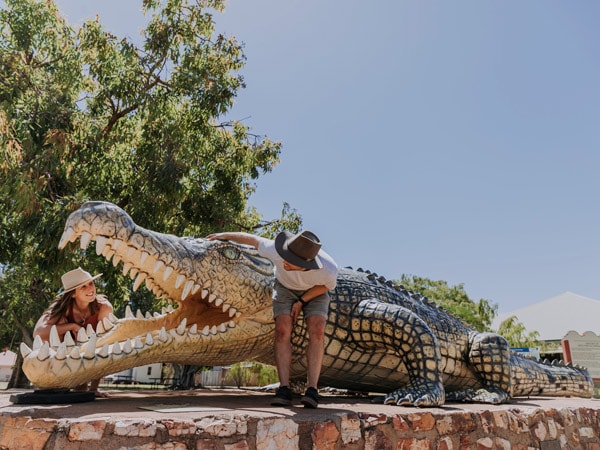
Meet Krys the Crocodile, the statue of Australia’s largest known crocodile. (Image: Tourism and Events Queensland)
Burketown on the Albert River is another terrific spot to tackle barramundi, so be sure to pack your fishing rod, or you can hire one locally. Take a sunset cruise or hot air balloon flight with Indigenous-owned Yagurli Tours.
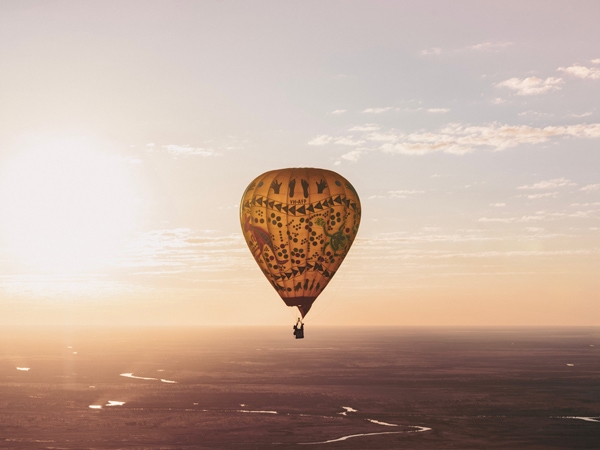
Take in the sights of Burketown from above in a hot air balloon. (Image: Tourism and Events Queensland)
Distance: 420kms — around 7.5 hours
Whiz on out west, filling up with petrol at Hells’ Gate Roadhouse and passing over the border into the Northern Territory. Your destination is working cattle station Seven Emu Station, where the campsites overlook the Robinson River. Enjoy birdwatching, fishing for trevally and mackerel, and chatting with the Shadforth family about their traditional Garawa culture. Seven Emu Station is accessible by 4WD only. Check road conditions before visiting.
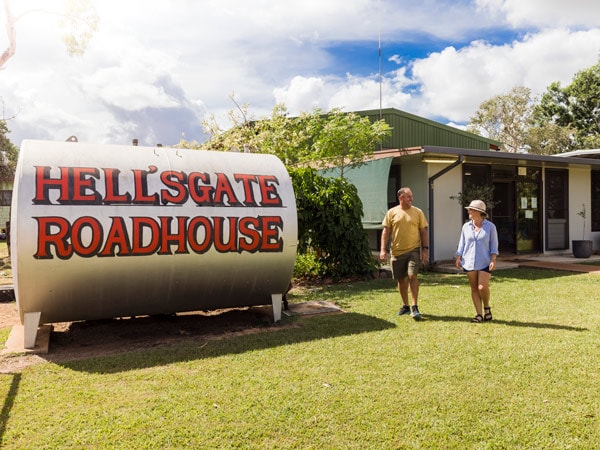
Refuel at Hell’s Gate Roadhouse on Westmoreland Road. (Image: Tourism and Events Queensland)
Detour: If you have time to spare, make a pit stop at a phenomenal outback oasis — Boodjamulla (Lawn Hill) National Park. Stay at Adels Grove Camping Park (reopening on 14 July 2023) and explore its emerald-green waters, fossil deposit, and red sandstone walls.
Distance: 484kms — around 8.5 hours
There’s no hiding the fact you have a long, lonely drive today, with only two towns along the way — Borroloola (where you can stock up on supplies) and Arnold with a population of about 30.
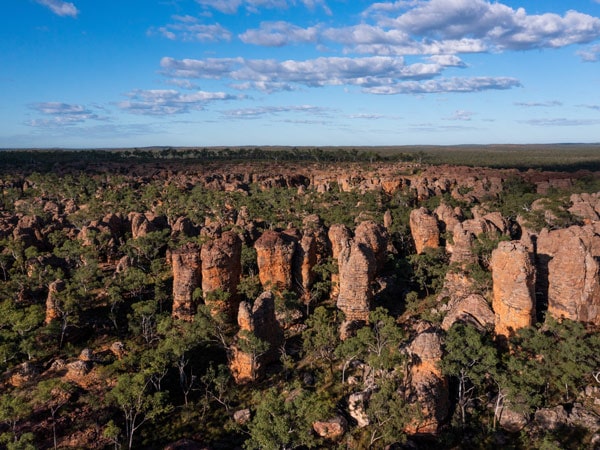
Admire stunning views of weathered sandstone pillars at Caranbirini Conservation Reserve. (Image: Tourism NT/Sean Scott)
Birdwatchers should detour to Caranbirini Conservation Reserve and keen anglers to King Ash Bay, renowned for its barramundi. Then you hit the Stuart Highway that runs from Darwin to Adelaide. Turn right and aim to stay at The Daly Waters Pub, which has a motel, cabins, budget rooms, and camping. The eccentric outback pub features bras hanging from the ceiling, and great beef-and-barramundi barbecues during the dry season.
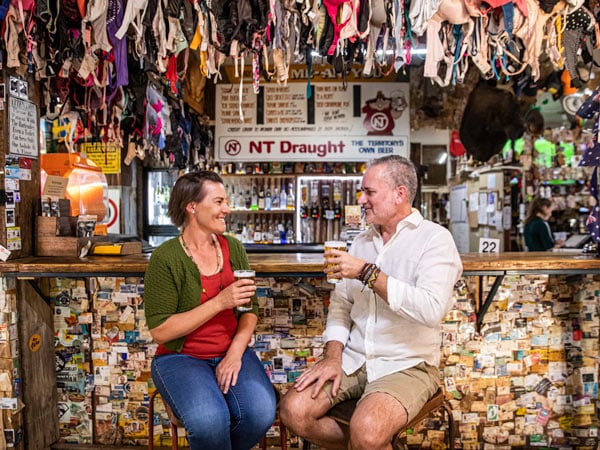
Grab a drink at the quirky Daly Waters Pub. (Image: Tourism NT/Helen Orr)
Distance: 280kms — around 3 hours
Heading north, pause at Larrimah, which has another historic bush pub (the highest bar in the Northern Territory), or in Mataranka, made famous in the 1908 Jeannie Gunn novel, We of the Never-Never. In adjacent Elsey National Park, you’ll find turquoise spring water pools perfect for a plunge, as well as a landscape patchworked with savannah woodland, stone country, and monsoon rainforest.
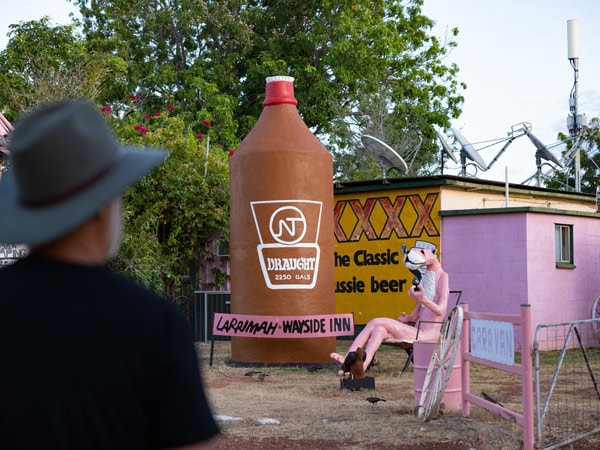
Pop into Larrimah Wayside Inn for a cold pint. (Image: Tourism NT/Sean Scott)
Overnight in Katherine or 20 minutes away at Nitmiluk (Katherine) Gorge, where you’ll find campgrounds and the luxury Cicada Lodge.
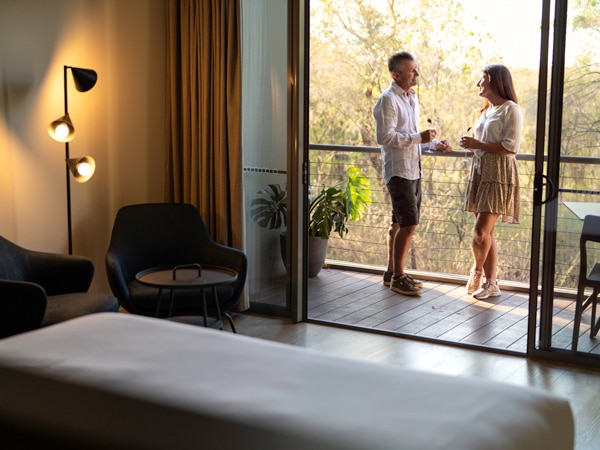
Stay in a luxe suite at Cicada Lodge. (Image: Tourism NT/Tourism Australia)
You’ll want to spend the day in this series of spectacular gorges in Nitmiluk National Park and stay for sunset when the cliffs glow red. Take a river cruise, paddle a hired kayak, or take to the hiking trails.
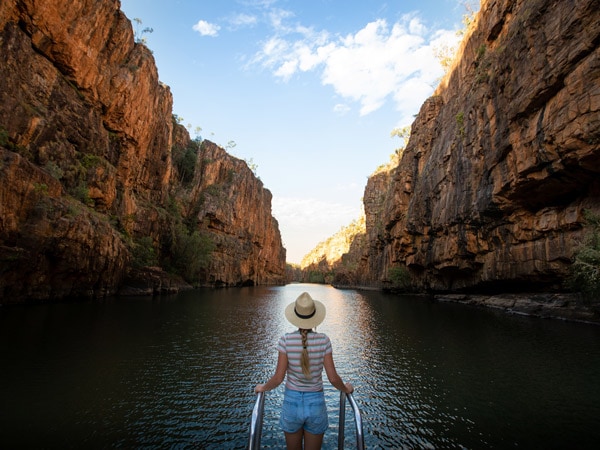
Tour Nitmiluk (Katherine) Gorge on a cruise. (Image: Tourism NT/Katie Goldie)
It’s worth splashing out on a scenic flight, which offers breathtaking views over the stunning countryside. Check out Baruwei Lookout for jaw-dropping views over the ancient gorge system.
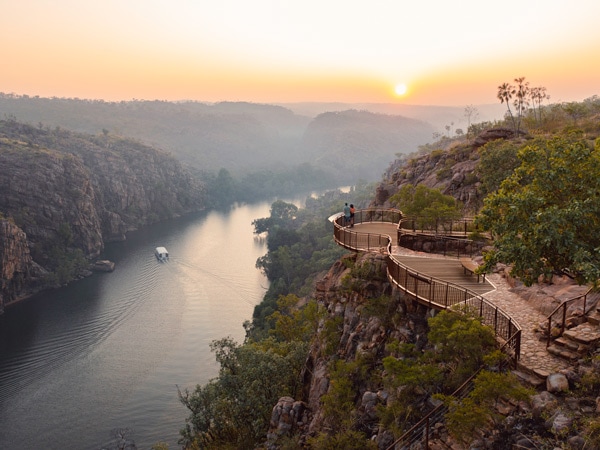
Baruwei Lookout offers breathtaking views of the spectacular gorge. (Image: Tourism NT/Tourism Australia)
Distance: 280kms — around 3 hours
As you move out the next day, Leliyn (Edith Falls) is another Nitmiluk National Park must-see where you can enjoy a swim or hike.
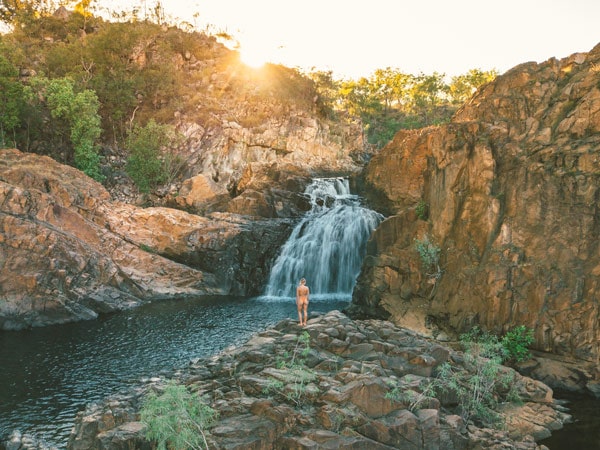
Take a sunrise dip at Edith Falls. (Image: Tourism NT/Mitch Cox)
Your next stops should be former gold-rush town Pine Creek and Adelaide River, famous for its jumping crocodile cruises. Finish your day in accommodation at Batchelor, gateway to Litchfield National Park, or camp in the park itself.
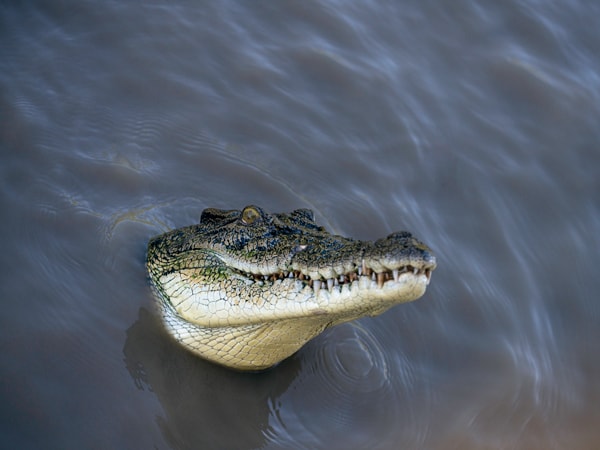
Spot the monster from the deep on a jumping crocodile cruise on the Adelaide River. (Image: Tourism NT/Tourism Australia)
There are plenty of waterfalls and waterholes (follow safety directions and check alerts for saltwater crocodiles before swimming) in Litchfield National Park that are accessible via sealed roads: Florence Falls and Buley Rockhole are popular among both locals and visitors.
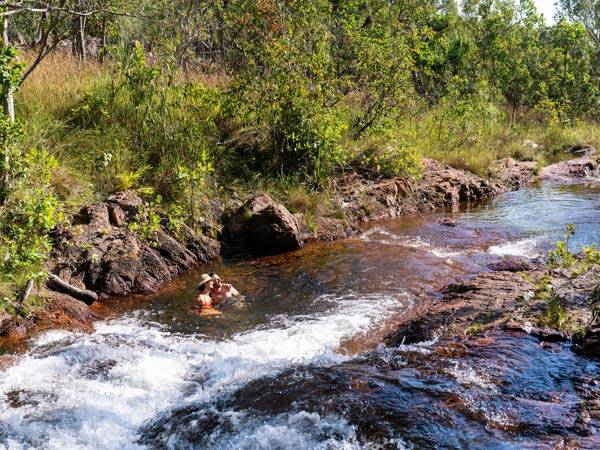
Buley Rockhole is tucked within rapid-flowing streams in Litchfield National Park. (Image: Tourism NT/Shaana McNaught)
Head to Wangi Falls where you can take a short rainforest walk or book a scenic helicopter flight year-round. Don’t forget to stop for a photo at the peculiar-looking magnetic termite mounds along the way, which take on an orange glow at sunset.
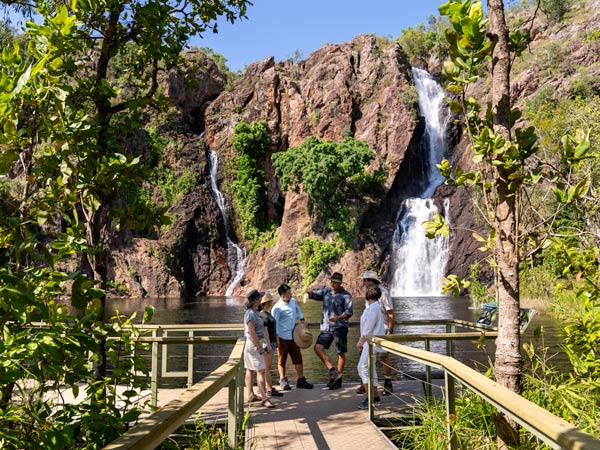
Litchfield National Park is home to scenic Wangi Falls. (Image: Tourism NT/Shaana McNaught)
Distance: 140kms — around 1.5 hours
Your destination is in sight, but you might also consider stopping at Berry Springs Nature Park for a swim in the cooling blue-green woodland pools and Territory Wildlife Park to see the full range of outback animals, including nocturnal creatures seldom seen in the wild.
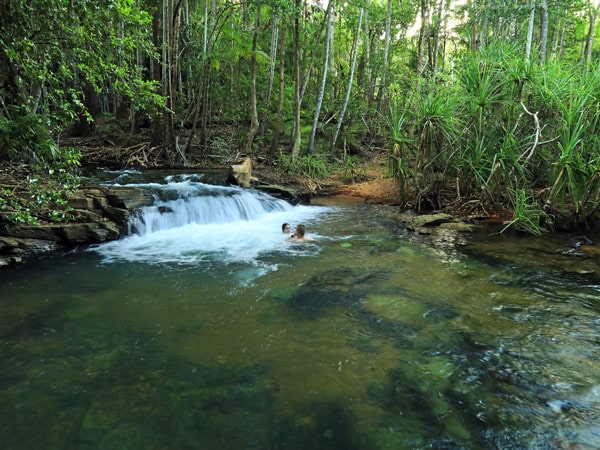
Cool off at Berry Springs Nature Park. (Image: Tourism NT)
Now you’ve arrived at Australia’s Top End, here’s our pick of the best things to see and do in and around Darwin.
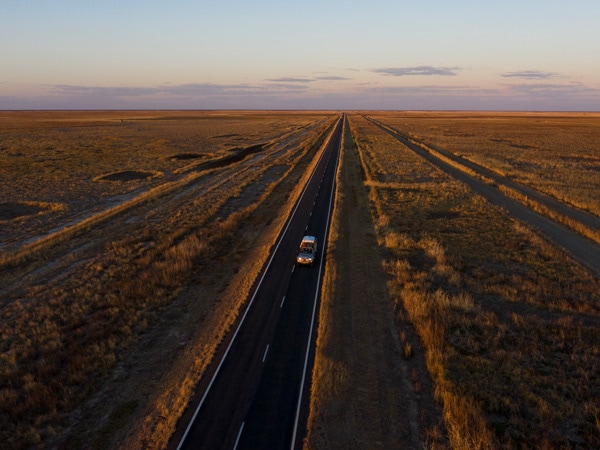
Venture across the Savannah Way from Cairns to Darwin. (Image: Tourism and Events Queensland)
Written by Brian Johnston with updates by Jemma Fletcher.
Good trip
Lorella Springs is a 4WD wonderland but make sure you go there before the waterholes dry out. The roads from Hells Gate and beyond are really tough so take it easy and have an extra spare tyre.
Sensational, thank you.